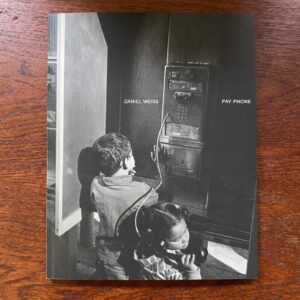JTF (just the facts): A total of 9 black and white photographs, framed in white and unmatted, and hung against white walls in the main gallery space. All of the works are described as “photo object with archival pigment print:” more clearly, they are archival pigment prints which have been cut by the artist, the black images mounted with black backing as opposed to white. The works were made in 2018 or 2019, are sized roughly 55×39 inches (or reverse), and are unique. (Installation and detail shots below.)
A monograph of earlier works in this ongoing project was published in 2017 by Hartman Books.
Comments/Context: The German artist Christiane Feser takes photographic illusionism in more unexpected directions than most of her contemporaries. She is by no means the first to see the potential for optical misdirection to be found in layered rephotography – nested images of images can quickly create confusions that an artist can exploit, and many contemporary photographers have explored what can be done with these kinds of imaginative deceptions. The harder question that most encounter is where to go once that relatively straightforward visual trickery is exhausted – a picture that satisfyingly fools a viewer once often fails to fool that same viewer again.
Feser has carved out a defensible artistic space for herself by not only smartly leveraging the natural dissonance of the image/object dichotomy of photography but also pushing her works further toward sophisticated investigations of surface and abstraction. From across a room, a Feser work looks like a standard flat black and white photograph, albeit one that seems to have an extraordinary degree of unexpected surface interest. Up close, it becomes clear that Feser’s images aren’t flat at all – they are truly sculptural, in that they have been cut, folded, and lifted above the typical one dimensionality of the picture plane.
This illusionism is created by Feser’s meticulous, or better yet surgical, matching of subject and effect. Her works begin with physical paper constructions made in her studio, generally fields of similar forms like rectangles, triangles, blocks, strips, and curves. These dense arrangements of geometric repetition are then photographed, the cast light across the uneven surfaces creating nuances of light and shadow in shades of gray.
Feser’s abstract compositions aren’t entirely strict and ordered – they don’t resolve into perfect fields or patterns like origami tessellations. Within her constructs, there is a small degree of human skew and randomness, and this gives the arrangements a more organic, sometimes jumbled, feel, like they are multiplying and evolving, but not within a completely rigid structure. This is important because this approach prevents us from predicting where the composition is going – the surface may (and often does) move somewhere we’re not expecting.
Feser then reimagines the surfaces of her works by cutting the physical prints in ways that echo the forms the photographs document. Sides of boxes are cut and folded, planes of triangles are raised and angled, and contoured teardrop forms are encouraged to bend and curve, and in each case, the light from the gallery casts another layer of actual shadow gradations across the ones already in the underlying photograph. In most cases, these cuts are backed by another sheet of white paper, but in a few works, a black backing material is used, making the cut-through hollows and insides dark instead of light.
In general, the cut effects double the thick all-overness of the original constructions, adding depth and presence to the existing flatness. Feser’s craftsmanship and intelligence comes through strongly in this facet of the work, as each cut precisely mimics the contours in the photograph underneath, creating lifts, depressions, and even inversions that play with our perception. When a shape that looks like it is going “down” physically goes “up”, or its shadow moves in a direction that is the opposite of what it appears, the works shine with perplexing, puzzle-solving vitality. Her surfaces undulate and shimmer in impossible ways, deliberately confounding our ability to understand them.
Two works are made from square tubes set on edge with their openings oriented upward. Playing with aspects of scale, proximity, and the proportional rising of the cuts, she creates two surfaces that seem to fall towards black hole centers, the topography of the boxes jittering as it nears the collapse point. Another pair of works makes the most of simple folded forms like the place cards at a dinner party. Feser has arranged the tented cards into horizontal stripes, the up and down oscillation of the cards upended by cut forms that work in the opposing direction, the shadowed sides alternately cut in ways that cause confusion. And one work uses peeled up strips of paper as its motif, creating a disorienting fluttering effect when the cuts and shadows play games.
Feser’s complex exercises in spatial dynamics constantly force the viewer into comparisons between appearance and “reality.” Feser’s original physical construction, her lit photograph of that installation, her cuts and folds of the resulting paper, and the final layer of lit presentation are all wrestling with each other, with no obvious advantage accruing to one aspect or another. As intricately hand crafted objects, Feser’s prints are undeniably impressive and remarkable, but it’s their resulting ability to make us step back, think, and reassess what we assume is happening that makes them durably intriguing. While we don’t usually consider abstractions as “brainy,” Feser’s photographic objects are just that – if they don’t challenge your ability to make sense of them, you’re not paying attention.
Collector’s POV: The works in this show are priced at $17500 each. Feser’s work has little secondary market history at this point, so gallery retail likely remains the best option for those collectors interested in following up.


















